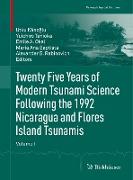- Start
- Twenty Five Years of Modern Tsunami Science Following the 1992 Nicaragua and Flores Island Tsunamis. Volume I
Twenty Five Years of Modern Tsunami Science Following the 1992 Nicaragua and Flores Island Tsunamis. Volume I
Angebote / Angebote:
After a relatively quiet 28-year period following the 1964 Alaska earthquake and tsunami, two 1992 earthquakes occurred near Nicaragua and Flores Island, Indonesia. These earthquakes produced highly destructive tsunamis and opened a 25-year period of numerous devastating events, including two of the most destructive natural disasters in recent human history: the 26 December 2004 Sumatra tsunami that killed about 230, 000 people and impacted at least 16 countries directly, and the 11 March 2011 Tohoku tsunami that killed almost 20, 000 people and destroyed the Fukushima Dai-ichi nuclear power plant. The two 1992 events marked the beginning of a "modern tsunami science era". The twenty-two papers in this special volume present the frontiers of tsunami science and research, and demonstrate the unprecedented progress achieved during this period. The contributions review historical tsunami events and field surveys, tsunami source models, landslide generated tsunamis, and tsunami numerical modeling. It concludes with contributions studying tsunami hazard assessment and warning, reflecting an everlasting challenge in the context of the advancement of tsunami science and of efforts in mitigation.
This book is of interest to scientists and practitioners as well postgraduate students in geophysics, oceanography and coastal engineering involved in all aspects of tsunamis, from earthquake source processes to transoceanic wave propagation, from coastal impacts to hazard assessment, combining recent case studies with advances in tsunami science and natural hazards mitigation.
Previously published in Pure and Applied Geophysics, Volume 176, Issue 7, 2019
Folgt in ca. 5 Arbeitstagen
